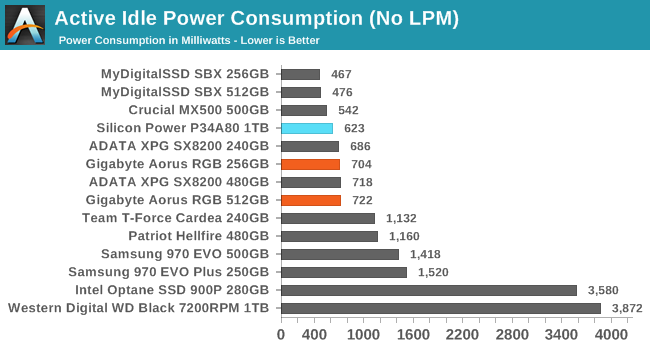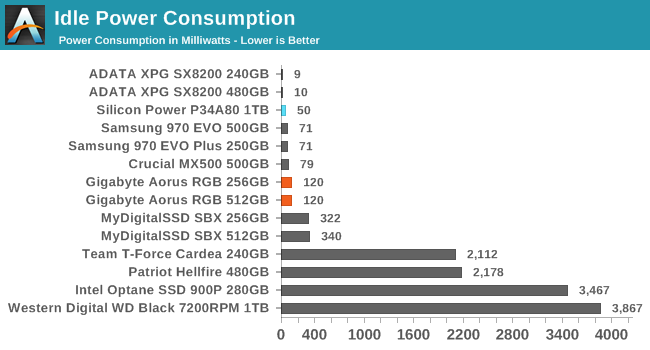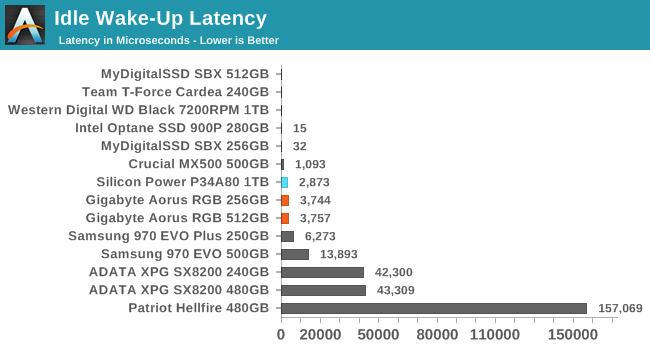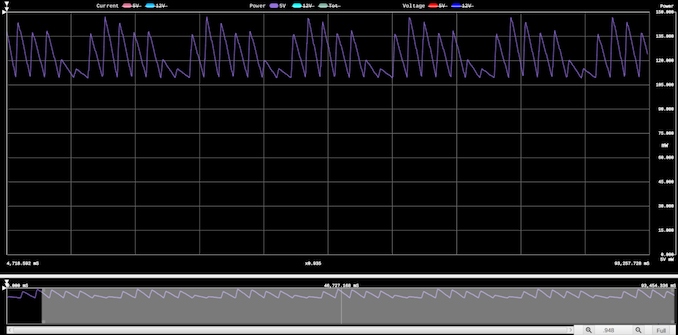The GIGABYTE Aorus RGB M.2 SSD Review: Nothing Is Too Small For RGB LEDs
by Billy Tallis on April 10, 2019 8:00 AM ESTPower Management Features
Real-world client storage workloads leave SSDs idle most of the time, so the active power measurements presented earlier in this review only account for a small part of what determines a drive's suitability for battery-powered use. Especially under light use, the power efficiency of a SSD is determined mostly be how well it can save power when idle.
For many NVMe SSDs, the closely related matter of thermal management can also be important. M.2 SSDs can concentrate a lot of power in a very small space. They may also be used in locations with high ambient temperatures and poor cooling, such as tucked under a GPU on a desktop motherboard, or in a poorly-ventilated notebook.
| GIGABYTE Aorus RGB M.2 NVMe Power and Thermal Management Features |
|||
| Controller | Phison PS5012-E12 | ||
| Firmware | ECFM12.1 | ||
| NVMe Version |
Feature | Status | |
| 1.0 | Number of operational (active) power states | 3 | |
| 1.1 | Number of non-operational (idle) power states | 2 | |
| Autonomous Power State Transition (APST) | Supported | ||
| 1.2 | Warning Temperature | 70°C | |
| Critical Temperature | 90°C | ||
| 1.3 | Host Controlled Thermal Management | Supported | |
| Non-Operational Power State Permissive Mode | Not Supported | ||
The power and thermal management feature set supported by the GIGABYTE Aorus SSD matches other Phison E12 drives. The maximum power ratings declared for the drive's active power states are lower than we've seen on 1TB Phison E12 drives. This is the first time I can recall encountering a product line that actually scales these values with capacity, though they're all still much higher than any of the sustained power consumption numbers we've measured. The idle power ratings have not been adjusted to account for the RGB LEDs.
| GIGABYTE Aorus RGB M.2 NVMe Power States |
|||||
| Controller | Phison PS5012-E12 | ||||
| Firmware | ECFM12.1 | ||||
| Power State |
Maximum Power |
Active/Idle | Entry Latency |
Exit Latency |
|
| PS 0 | 6.77 W (256GB) 8.09 W (512GB) |
Active | - | - | |
| PS 1 | 5.71 W (256GB) 6.37 W (512GB) |
Active | - | - | |
| PS 2 | 5.19 W (256GB) 5.52 W (512GB) |
Active | - | - | |
| PS 3 | 49 mW | Idle | 2 ms | 2 ms | |
| PS 4 | 1.8 mW | Idle | 25 ms | 25 ms | |
Note that the above tables reflect only the information provided by the drive to the OS. The power and latency numbers are often very conservative estimates, but they are what the OS uses to determine which idle states to use and how long to wait before dropping to a deeper idle state.
Idle Power Measurement
SATA SSDs are tested with SATA link power management disabled to measure their active idle power draw, and with it enabled for the deeper idle power consumption score and the idle wake-up latency test. Our testbed, like any ordinary desktop system, cannot trigger the deepest DevSleep idle state.
Idle power management for NVMe SSDs is far more complicated than for SATA SSDs. NVMe SSDs can support several different idle power states, and through the Autonomous Power State Transition (APST) feature the operating system can set a drive's policy for when to drop down to a lower power state. There is typically a tradeoff in that lower-power states take longer to enter and wake up from, so the choice about what power states to use may differ for desktop and notebooks.
We report two idle power measurements. Active idle is representative of a typical desktop, where none of the advanced PCIe link or NVMe power saving features are enabled and the drive is immediately ready to process new commands. The idle power consumption metric is measured with PCIe Active State Power Management L1.2 state enabled and NVMe APST enabled if supported.


The LED lighting doesn't do much to hurt the idle power management of the Aorus SSD, only adding about 70mW compared to a plain 1TB Phison E12 drive. The Aorus RGB barely stands out from the field of competitors with well-behaved power management, and it is significantly less power-hungry at idle than several of the drives with somewhat broken power management, such as the older Phison E7 SSDs. The averages shown above are for the default color-cycling behavior of the SSD. The graph below from Quarch Power Studio shows how the power draw fluctuates with brightness and depending on which color the drive is displaying, but the LEDs don't account for too much power overall.

The Aorus SSDs take a bit longer to come out of sleep than the previous Phison E12 drive we tested, but at slightly less than 4ms it's still a reasonably quick wake-up period, and far faster than the ADATA SX8200.











23 Comments
View All Comments
austinsguitar - Wednesday, April 10, 2019 - link
conclusion: its actually pretty good.Flunk - Wednesday, April 10, 2019 - link
At this point I think I'd pay a bit extra to NOT have non-functional LEDs on my computer hardware.FreckledTrout - Wednesday, April 10, 2019 - link
I like the idea of LED's but hate the cute way most get implemented. Vendors could make them all functional with a little effort. Change colors due to CPU temps, backlight ports and even change color on said back light when something gets plugged in. Color code audio ports with light. Im sure Im missing some. I actually don't mind being able to see into my case to check for dust bunnies or make sure fans are spinning without opening the case up.CheapSushi - Wednesday, April 10, 2019 - link
Or allow them to be Activity LEDs. :( None of the software implementations seem to allow this.CheapSushi - Wednesday, April 10, 2019 - link
You have practically hundreds of SSD choices. Stop whining.Thud2 - Wednesday, April 10, 2019 - link
Sorry, a bit off topic but seems the perfect place to ask. What is that below the eagles head? An arm? A huge jaw?Hxx - Wednesday, April 10, 2019 - link
good question. All i can tell u is that its derived from Horus (ancient Egypt). I know bc Gigabyte mentioned it in one of their early vidz. As far as what that thing is, likely a jaw resembling letter G, i dont believe its in arm.andychow - Wednesday, April 10, 2019 - link
The eagle is shaking his fist. Aorus (Horus) is a man with an eagle head, that's why he has arms and not wings. And he's shaking his fist because he's a bad-ass.philehidiot - Wednesday, April 10, 2019 - link
Yeh what Andychow said. Horus with the fist and bicep. He's such a badass that he's now stopped battling Set but is sponsoring SSDs instead. Because.... badass.Duwelon - Thursday, April 11, 2019 - link
An arm. Specifically,. a well-toned right arm, ready to go. Does Gigabyte know the types of people that want RBG on their M.2 drives or what?